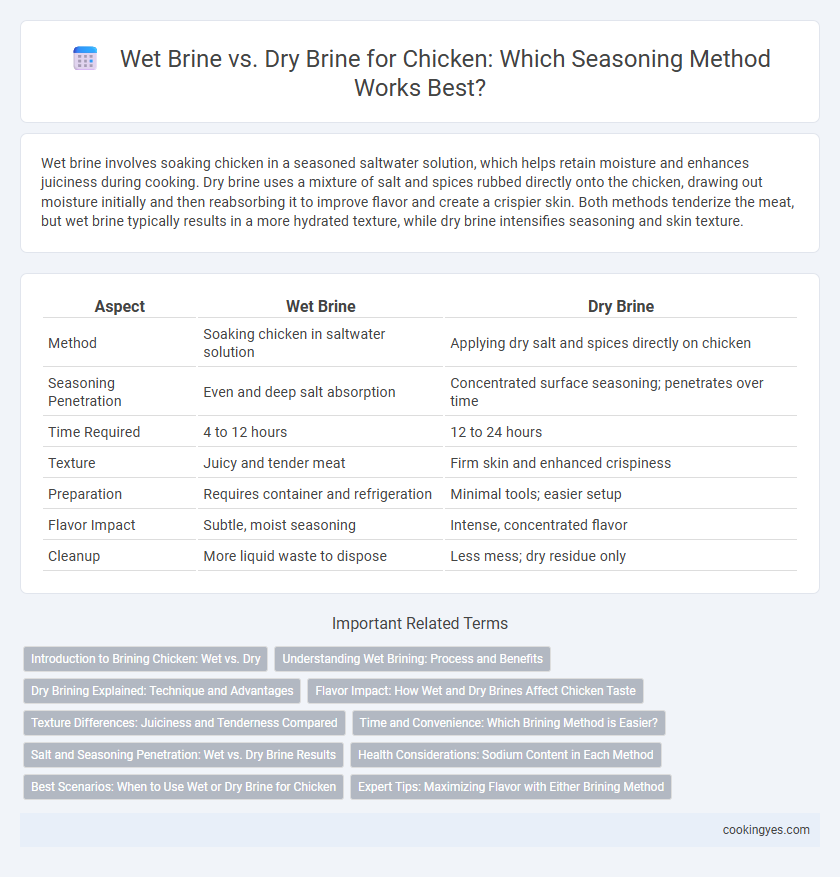Wet brine involves soaking chicken in a seasoned saltwater solution, which helps retain moisture and enhances juiciness during cooking. Dry brine uses a mixture of salt and spices rubbed directly onto the chicken, drawing out moisture initially and then reabsorbing it to improve flavor and create a crispier skin. Both methods tenderize the meat, but wet brine typically results in a more hydrated texture, while dry brine intensifies seasoning and skin texture.
Table of Comparison
| Aspect | Wet Brine | Dry Brine |
|---|---|---|
| Method | Soaking chicken in saltwater solution | Applying dry salt and spices directly on chicken |
| Seasoning Penetration | Even and deep salt absorption | Concentrated surface seasoning; penetrates over time |
| Time Required | 4 to 12 hours | 12 to 24 hours |
| Texture | Juicy and tender meat | Firm skin and enhanced crispiness |
| Preparation | Requires container and refrigeration | Minimal tools; easier setup |
| Flavor Impact | Subtle, moist seasoning | Intense, concentrated flavor |
| Cleanup | More liquid waste to dispose | Less mess; dry residue only |
Introduction to Brining Chicken: Wet vs. Dry
Wet brine involves soaking chicken in a saltwater solution, enhancing moisture retention and flavor penetration through osmosis. Dry brine applies salt directly to the skin and meat, drawing out juices that reabsorb, resulting in a more concentrated seasoning and crispier skin. Both methods improve juiciness and tenderness, but wet brining adds extra moisture, while dry brining intensifies the natural taste and texture.
Understanding Wet Brining: Process and Benefits
Wet brining involves soaking chicken in a saltwater solution, which helps the meat retain moisture and enhances flavor. This process allows salt to penetrate deeply, breaking down muscle fibers for a tender, juicy texture. Benefits of wet brining include improved seasoning uniformity and prevention of dryness during cooking.
Dry Brining Explained: Technique and Advantages
Dry brining chicken involves coating it with salt and optional seasonings, allowing the salt to penetrate the meat and enhance flavor and moisture retention. This technique improves texture by breaking down muscle proteins, resulting in juicier, more tender chicken with a crispy skin when cooked. Compared to wet brining, dry brining requires less space and time, reduces waste, and intensifies the natural chicken flavor without diluting it.
Flavor Impact: How Wet and Dry Brines Affect Chicken Taste
Wet brining infuses chicken with moisture and a mild, evenly distributed saltiness that enhances juiciness and tenderness, while dry brining intensifies the chicken's natural flavors by drawing out and then reabsorbing its own juices, creating a more concentrated taste. Wet brines can slightly dilute the flavor due to water absorption, whereas dry brines result in a deeper, more robust seasoning that penetrates the skin and meat. Both methods improve flavor, but dry brining is preferred for a more pronounced, savory profile without added liquid.
Texture Differences: Juiciness and Tenderness Compared
Wet brine enhances chicken juiciness by absorbing water and salt, leading to a more succulent texture through cell protein denaturation. Dry brine, using salt applied directly to the skin, draws out moisture then reabsorbs it, resulting in firmer meat with concentrated flavors and improved tenderness. The choice between wet and dry brining significantly impacts the final texture, with wet brines promoting moisture retention and dry brines boosting skin crispness and flavorful depth.
Time and Convenience: Which Brining Method is Easier?
Wet brine requires submerging chicken in a saltwater solution, typically needing 4 to 12 hours for effective seasoning, which can be less convenient due to space and refrigeration constraints. Dry brine involves rubbing salt and spices directly onto the chicken's skin, allowing for a quicker setup and more flexibility in timing, generally needing 1 to 2 hours or overnight. For time-conscious cooks, dry brining offers a simpler, less time-intensive method without compromising flavor or moisture retention.
Salt and Seasoning Penetration: Wet vs. Dry Brine Results
Wet brining chicken involves submerging it in a saltwater solution, which allows salt and seasonings to penetrate deeply and evenly, resulting in a juicier texture. Dry brining uses coarse salt directly on the chicken's surface, drawing moisture out and then reabsorbing it with concentrated flavors, enhancing the skin's crispness and seasoning intensity. Both methods improve salt penetration, but wet brine provides more uniform moisture retention while dry brine offers a stronger, more concentrated flavor profile.
Health Considerations: Sodium Content in Each Method
Wet brining chicken involves submerging it in a saltwater solution, which can lead to higher sodium absorption compared to dry brining, where salt is applied directly to the skin and penetrates more slowly. Dry brining typically results in lower overall sodium content, making it a preferred method for those monitoring sodium intake for health reasons. Choosing dry brine helps control sodium levels while still enhancing flavor and moisture retention in chicken.
Best Scenarios: When to Use Wet or Dry Brine for Chicken
Wet brine is ideal for larger cuts like whole chickens or bone-in pieces, as its saltwater solution penetrates deeply, ensuring juicy and evenly seasoned meat. Dry brine works best for smaller cuts or when time is limited, allowing the salt to draw out moisture and then reabsorb it, enhancing flavor and crisping the skin. Choosing wet brine benefits roasting or smoking, while dry brine excels for pan-searing or grilling chicken breasts or thighs.
Expert Tips: Maximizing Flavor with Either Brining Method
Wet brine involves soaking chicken in a saltwater solution, enhancing moisture retention and infusing even seasoning throughout the meat. Dry brine uses salt and seasonings rubbed directly onto the skin, concentrating flavors and improving skin crispiness by drawing out and reabsorbing juices. Expert tips recommend wet brining for juiciness in thicker cuts and dry brining for a firmer texture and more intense, well-balanced flavors.
Wet brine vs Dry brine for chicken seasoning Infographic

 cookingyes.com
cookingyes.com